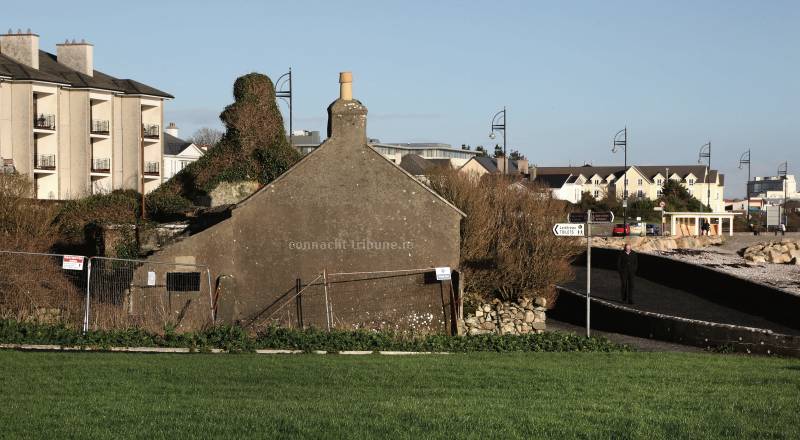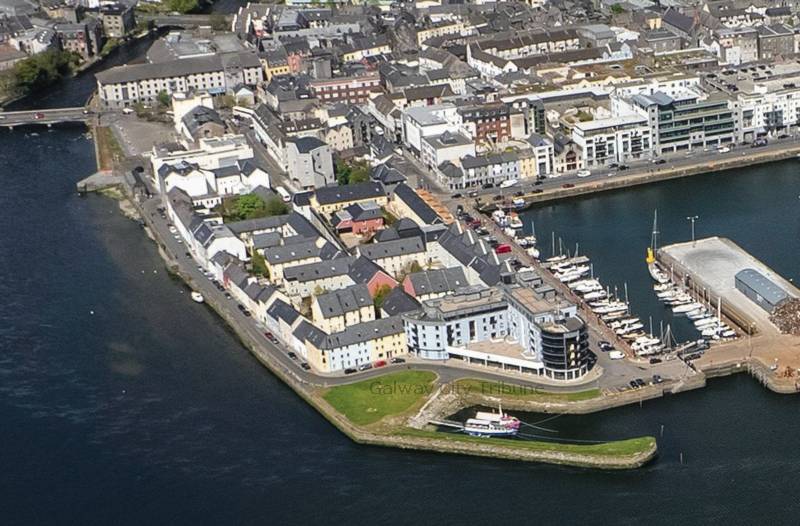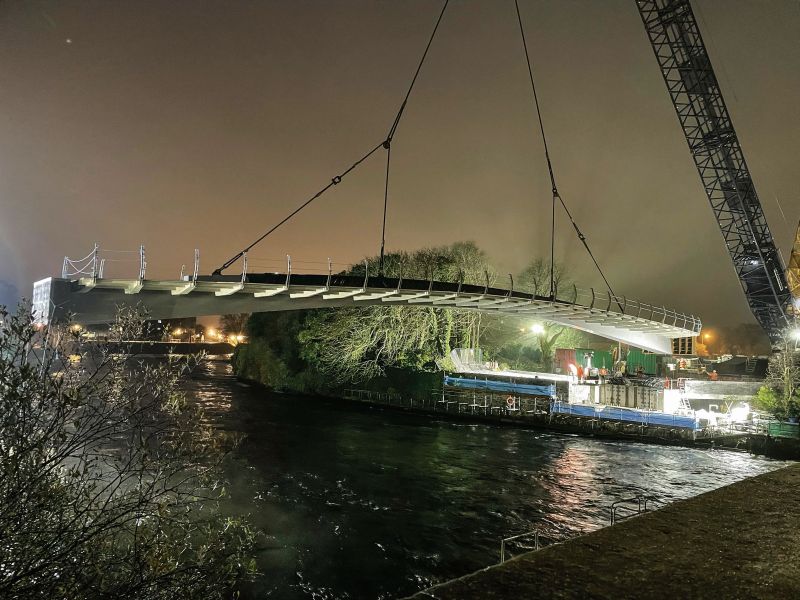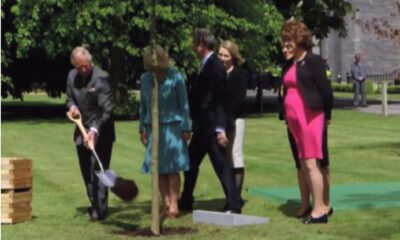CITY TRIBUNE
Plans drawn up to redevelop derelict Blackrock cottage

Plans have been drawn up to restore the derelict 19th century cottage at Blackrock and create a restaurant with adjoining bicycle hire shop to serve as a stop-off along the Wild Atlantic Way.
The proposal includes the refurbishment of Blackrock Cottage to a café/restaurant and the construction of a single-storey detached bicycle rental and repair shop, and 18 parking spaces with access onto the main Salthill Road. 
Cork-based McHugh Property Holdings Ltd – where former Galway footballer Finian Hanley serves as Chief Operating Officer – lodged the application at City Hall last week.
“This site has sat for many years as a derelict eyesore on one of the city’s busiest recreational amenities, used by the local and visiting public.
“The aim in this application is to secure the restoration and long-term future of the existing cottage and to do so by means of a use which is complementary to the area.
“The bicycle rental and repair element is also complementary to the established recreation use and will support an alternative means of experiencing the coastal areas in the city in a sustainable way.
“Both the café and the cycle elements will add to and enhance the prominent role of Salthill and Blackrock in the city as the primary year-round recreation areas.
“Additionally, the proposed development will enhance the public realm of the area through the restoration of the disused cottage, the reduction in the boundary wall and extensive landscaping, in particular, the access track to the existing public toilets which is currently overgrown.
“The conservation and refurbishment will be done in a manner sympathetic to the historic nature of the building. The proposal involves the construction of a new building and elements that are entirely contemporary in design. This is proposed as a low, flat-roofed building so as to respect the sensitivity of views and to be subservient to the traditional character of the restored cottage.
“The project allows for a sustainable rejuvenation of this derelict eyesore with an attractive restoration of the cottage to its former glory, while offering a much-needed ancillary facility,” architect Sean Dockry said.
Mayor Niall McNelis told the Galway City Tribune that he fully supports the plans. “I think it’s a fantastic idea. Galway City Council should have bought it and developed it themselves. It will be great for tourism on the Wild Atlantic Way at what is one of the city’s biggest attractions.”
The company behind the plans is owned by Cork businessman Brian McHugh, who also owns McHugh Insulation and Envirobead.
A subsidiary company, Clearwater Ventures, owns the former Spinnaker Hotel and adjoining retail units, which were rezoned for ‘R’ usage, which would allow for residential development, hotel, guesthouse, local shops, offices and community buildings.
Clearwater is 75% owned by Mr McHugh, while Galway businessman Francis O’Flaherty – the Chief Operating Officer at Declan Ganley’s Rivada Networks – owns the remainder.
In 2008, the then owner of the Spinnaker, Ronan Lawless, was granted permission for a €30 million upmarket boutique with 26 bedrooms and bar and 16 apartments over three and four storeys (plus basement). That planning permission expired last December.
CITY TRIBUNE
Galway ‘masterplan’ needed to tackle housing and transport crises

From the Galway City Tribune – An impassioned plea for a ‘masterplan’ that would guide Galway City into the future has been made in the Dáil. Galway West TD Catherine Connolly stated this week that there needed to be an all-inclusive approach with “vision and leadership” in order to build a sustainable city.
Deputy Connolly spoke at length at the crisis surrounding traffic and housing in Galway city and said that not all of the blame could be laid at the door of the local authority.
She said that her preference would be the provision of light rail as the main form of public transport, but that this would have to be driven by the government.
“I sat on the local council for 17 years and despaired at all of the solutions going down one road, metaphorically and literally. In 2005 we put Park & Ride into the development plan, but that has not been rolled out. A 2016 transport strategy was outdated at the time and still has not been updated.
“Due to the housing crisis in the city, a task force was set up in 2019. Not a single report or analysis has been published on the cause of the crisis,” added Deputy Connolly.
She then referred to a report from the Land Development Agency (LDA) that identified lands suitable for the provision of housing. But she said that two-thirds of these had significant problems and a large portion was in Merlin Park University Hospital which, she said, would never have housing built on it.
In response, Minister Simon Harris spoke of the continuing job investment in the city and also in higher education, which is his portfolio.
But turning his attention to traffic congestion, he accepted that there were “real issues” when it came to transport, mobility and accessibility around Galway.
“We share the view that we need a Park & Ride facility and I understand there are also Bus Connects plans.
“I also suggest that the City Council reflect on her comments. I am proud to be in a Government that is providing unparalleled levels of investment to local authorities and unparalleled opportunities for local authorities to draw down,” he said.
Then Minister Harris referred to the controversial Galway City Outer Ring Road which he said was “struck down by An Bord Pleanála”, despite a lot of energy having been put into that project.
However, Deputy Connolly picked up on this and pointed out that An Bord Pleanála did not say ‘No’ to the ring road.
“The High Court said ‘No’ to the ring road because An Bord Pleanála acknowledged it failed utterly to consider climate change and our climate change obligations.
“That tells us something about An Bord Pleanála and the management that submitted such a plan.”
In the end, Minister Harris agreed that there needed to be a masterplan for Galway City.
“I suggest it is for the local authority to come up with a vision and then work with the Government to try to fund and implement that.”
CITY TRIBUNE
Official opening of Galway’s new pedestrian and cycle bridge

The new Salmon Weir pedestrian and cycle bridge will be officially opened to the public next Friday, May 26.
Work on the €10 million bridge got underway in April 2022, before the main structure was hoisted into place in early December.
A lunchtime tape-cutting ceremony will take place on Friday, as the first pedestrians and cyclists traverse the as-yet-unnamed bridge.
The Chief Executive of Galway City Council, Brendan McGrath, previously said the bridge, once opened, would remove existing conflicts between pedestrians, cyclists and traffic “as well as facilitating the Cross-City Link public transport corridor over the existing 200-year-old bridge”.
The naming of the new bridge has been under discussion by the Council’s Civic Commemorations Committee since late last year.
One name that has been in the mix for some time is that of the first woman in Europe to graduate with an engineering degree – Alice Perry.
Ms Perry, who was from Wellpark, graduated from Queen’s College Galway (now University of Galway) in 1906. The university’s engineering building is named in her honour.
The bridge was built by Jons Civil Engineering firm in County Meath and was assembled off-site before being transported to Galway. Funding for the project was provided in full by the National Transport Authority and the European Regional Development Fund.
(Photo: Sheila Gallagher captured the city’s new pedestrian footbridge being raised on the south side of the Salmon Weir Bridge in December. It will officially open next Friday, May 26).
CITY TRIBUNE
Minister branded ‘a disgrace’ for reversing land rezoning in Galway City

From the Galway City Tribune – Minister of State for Local Government and Planning, Kieran O’Donnell was labelled a “disgrace” for overturning councillors’ decisions to rezone land in the new City Development Plan.
Minister O’Donnell (pictured) confirmed in a letter to Council Chief Executive Brendan McGrath last week that he was reversing 25 material alternations made by councillors to the CDP 2023-29. He made the decision on the advice of Office of Planning Regulator (OPR).
Minister O’Donnell directed that 14 land parcels that were subject to land-use zoning changes by councillors as part of the Material Alterations to the Draft CDP should be reversed.
He directed that a further 11 land parcels in the city should become “unzoned”.
The Minister found that the CDP had not been made in a manner consistent with recommendations of the OPR, which required specific changes to the plan to ensure consistency with the national planning laws and guidelines.
At last week’s Council meeting Cllr Eddie Hoare (FG) asked for clarity on the process by which councillors could rezone the lands that had been changed by the Minister’s direction.
Cllr Declan McDonnell said, “What he [Minister O’Donnell] has done is an absolute disgrace”.
And he asked: “Do we have to have another development plan meeting to deal with it?”
Both Cllrs Hoare and McDonnell wondered what would become of the lands that were rezoned or unzoned by the ministerial direction.
Mr McGrath said the Council had put forward an argument in favour of retaining the material alterations in the plan, but ultimately the Minister sided with OPR.
He said if councillors want to make alterations to the new plan, they could go through the process of making a material alteration but this was lengthy.
The Save Roscam Peninsula campaign welcomed the Minister’s decision.
In a statement to the Galway City Tribune, it said the direction would mean the Roscam village area on the Roscam Peninsula will be unzoned and a number of land parcels would revert back to agriculture/high amenity.
A spokesperson for the campaign said: “the material alterations made by city councillors following lobbying by developers continued the long-standing practice of councillors facilitating a developer-led plan rather than an evidence- and policy-based plan that meets the needs of the city.
“The Minister’s direction is an important step in restoring confidence in the planning system. It is clear from the City Council’s own evidence on future housing projections that there was no requirement to zone these lands for residential purposes in order to meet the needs of the targeted population increase up to 2029,” the spokesperson added.















